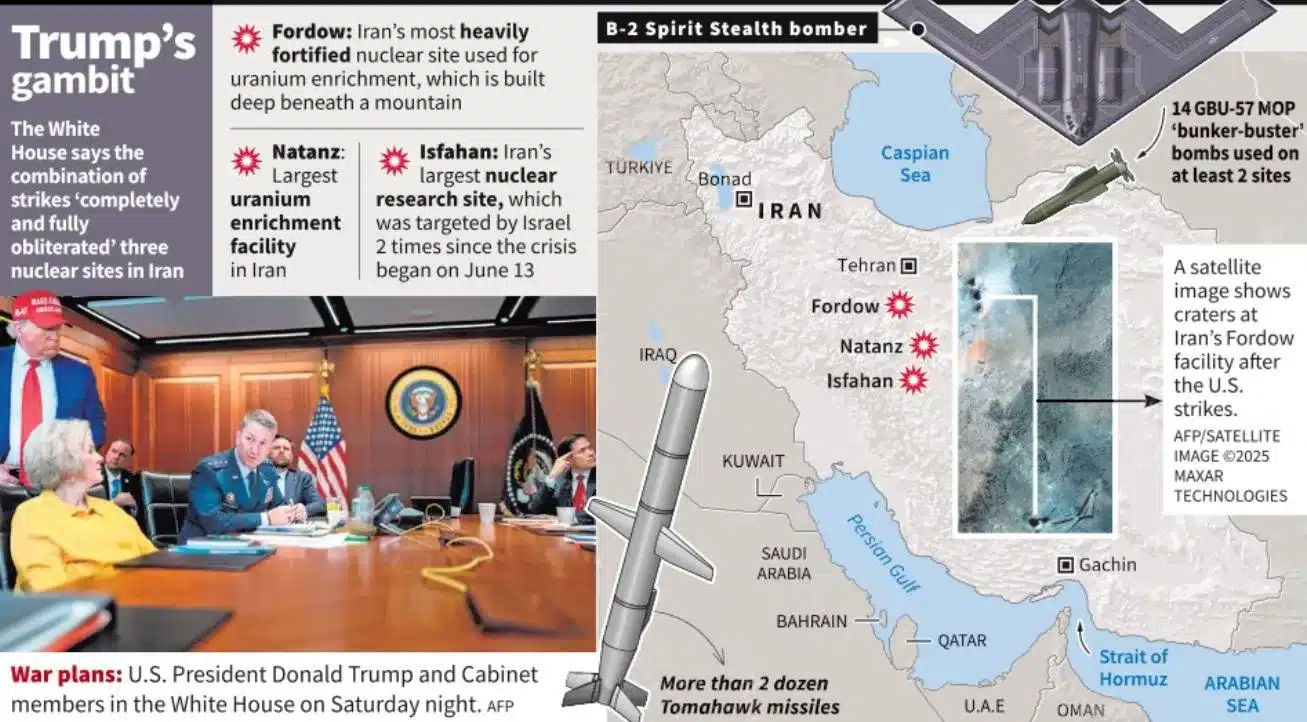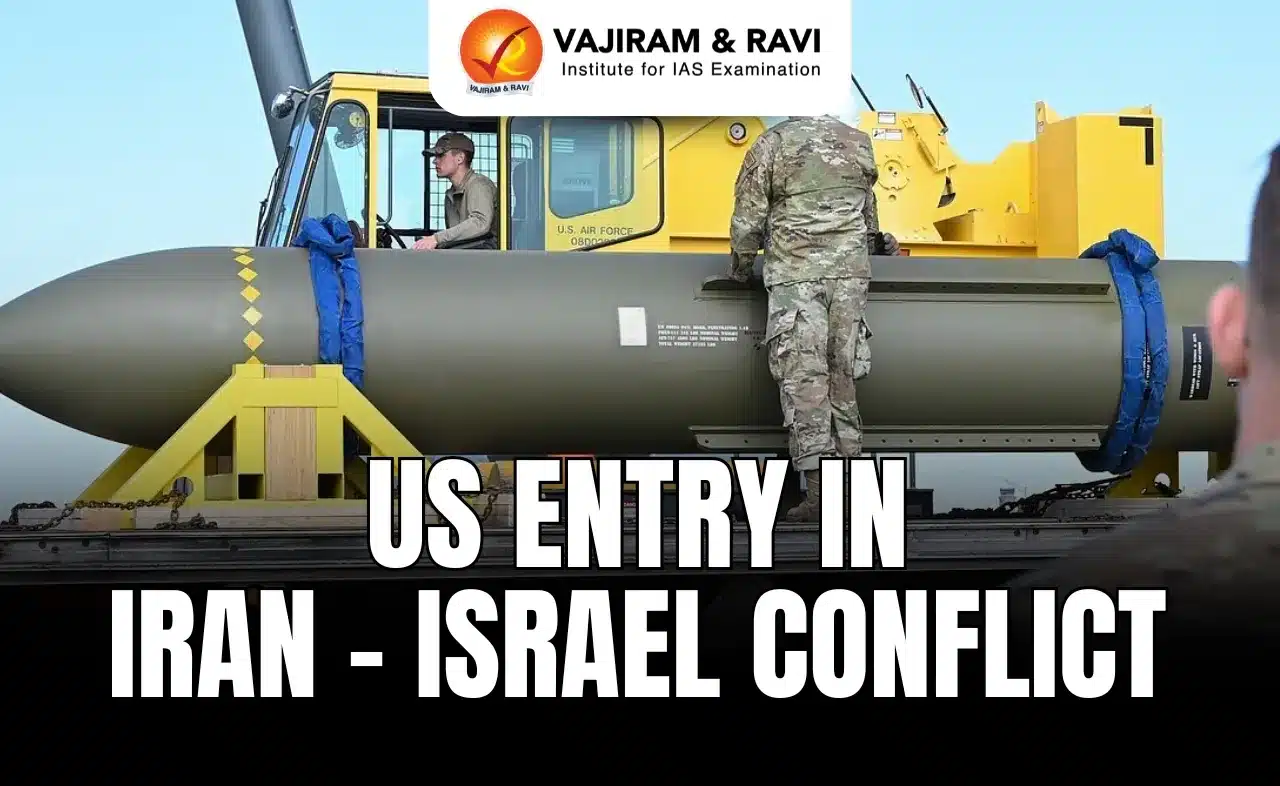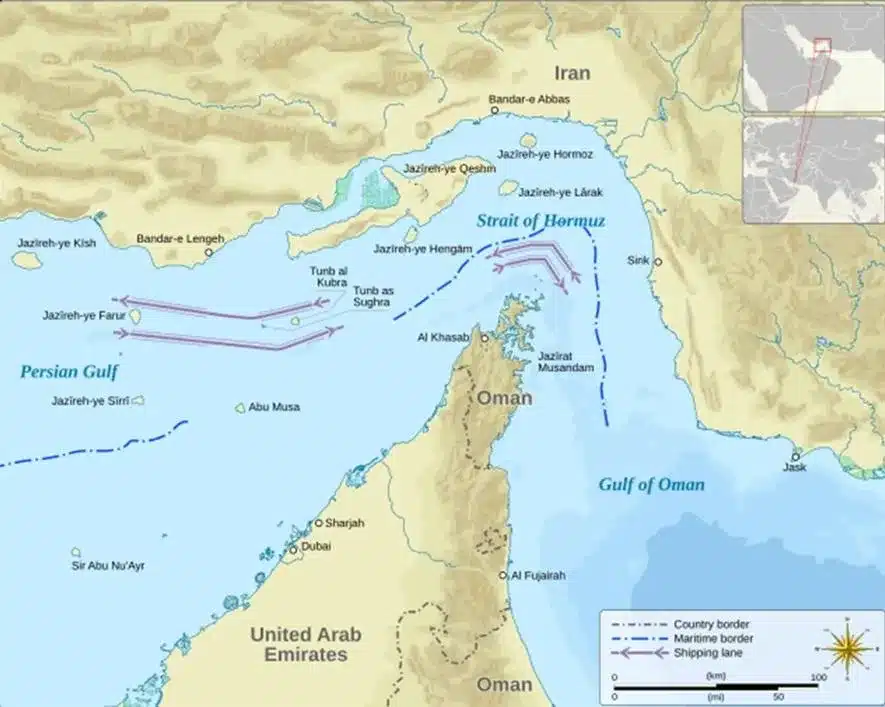US Entry in Iran - Israel Conflict Latest News
- The United States entered the Israel-Iran conflict by bombing three Iranian nuclear facilities using advanced B-2 stealth bombers and bunker-busting bombs, including a strike on the heavily fortified Fordow Uranium Enrichment Plant.

Key Takeaways From the US Strikes on Iran’s Nuclear Facilities
- US President announced a major military strike on three Iranian nuclear sites—Fordow, Natanz, and Isfahan.
- The strikes, conducted using a full payload of bombs, mark the US’s entry into the ongoing Israel-Iran conflict.
US-Israel Alliance Reaches New Heights
- The US has transitioned from support to direct military involvement in Israel’s offensive against Iran.
- Previously offering intelligence and defense assistance, the US now demonstrates "iron-clad" support through direct strikes, reinforcing Israel’s claims that Iran poses an existential nuclear threat.
A Shift from Trump’s ‘No Endless Wars’ Doctrine
- President Trump, who campaigned against US involvement in foreign wars and promised military restraint, has taken a stark turn by ordering strikes on Iran.
- This contradicts his longstanding position, including his pledge to end the Ukraine conflict within 24 hours and avoid entanglement in the Middle East.
Strategic Victory for Israel
- The US strike on Fordow has handed Israel a critical win, as it lacked the capability to destroy the deeply buried nuclear facility.
- This fulfills Israel’s long-standing objective of degrading Iran’s nuclear program and marks its strongest position against Iran since the 1979 Islamic Revolution.
A Humiliated and Weakened Iran
- Iran is reeling under the impact of continuous Israeli assaults.
- With over 600 casualties in just over a week and the degradation of Iran-backed groups like Hamas and Hezbollah, the Islamic Republic is facing its weakest strategic moment in over four decades.
Erosion of the 'Axis of Resistance'
- Israel’s sustained offensive has significantly weakened Iran’s regional proxies.
- The decline of Hamas and Hezbollah has not only isolated Iran but also paved the way for direct strikes on Iranian soil, with little resistance—a symbolic and strategic low for Tehran.
Echoes of Iraq: Legitimacy of US Strikes Questioned
- Iran has condemned the US strikes as violations of its sovereignty and international law.
- Critics draw parallels to the 2003 Iraq invasion, where the US falsely claimed Iraq had Weapons of Mass Destruction.
- The move raises questions about Washington’s credibility and motives in the region, especially as nuclear-armed nations target a non-nuclear state.
Iran’s Nuclear Future in Question
- Despite decades of resilience against sanctions and attacks, Iran’s scientific community now faces its toughest test.
- The world is watching to see if Iran will rebuild its nuclear program—and whether it will finally take the step toward developing nuclear weapons in response to escalating threats.
Escalating Middle East Turmoil
- Iran’s potential retaliation through ballistic missile and rocket attacks in the Persian Gulf and Red Sea could disrupt shipping lanes, raise oil prices, and destabilize the region.
- The partial blockade of the Strait of Hormuz on Sunday marks a significant escalation.
Risk of Wider Regional Conflict
- If Iran targets US bases or troops, the conflict could expand, drawing in Gulf nations like Saudi Arabia, UAE, Oman, and Qatar.
- Such a scenario would strain diplomatic and economic stability across the Middle East.
High Stakes for India
- India has deep strategic and economic ties to the region.
- With over 8 million Indians residing in the Middle East and heavy dependence on regional oil supplies (60% of total needs), escalating tensions directly threaten Indian citizens, energy security, and inflation control.
Impact on India's Regional Initiatives
- The India-Middle East-Europe Economic Corridor (IMEEC), a key geopolitical and trade initiative, depends on regional peace.
- Continued conflict could derail India’s long-term strategic interests and partnerships in the region.
Bunker-Buster MOP and B-2 Spirit Stealth Bomber
- US used the GBU-57 Massive Ordnance Penetrator (MOP) to target Iran's deeply buried Fordow nuclear facility.
- The bomb, deployable only by the B-2 Spirit stealth bomber, was used for the first time.
Bunker-Buster MOP
- The GBU-57 MOP is the US Air Force's most powerful non-nuclear bomb, capable of penetrating 60 meters of earth.
- It measures about 20.5 feet in length and 31.5 inches in diameter and weighs about 13,000 kgs
- Developed post-Iraq invasion by Boeing, it targets fortified underground sites.
- Its first known combat use was in the recent US airstrikes on Iran’s Fordow nuclear facility.
B-2 Spirit Stealth Bomber
- The B-2 Spirit is a long-range, stealth strategic bomber designed to evade advanced air defenses and deliver heavy payloads, including the GBU-57 MOP.
- Operated by the US Air Force, it combines cutting-edge stealth technology with global strike capability, making it a key asset in high-value, deep-penetration missions.
US Entry in Iran-Israel Conflict FAQs
Q1: Which nuclear sites did the US bomb in Iran?
Ans: The US targeted Fordow, Natanz, and Isfahan—key sites in Iran’s nuclear program—using B-2 bombers and advanced munitions.
Q2: What bomb was used by the US in Iran strikes?
Ans: The US used the GBU-57 MOP, a powerful bunker-buster designed to destroy deeply buried fortified underground nuclear facilities.
Q3: Why is this strike significant for Israel?
Ans: Israel lacked capacity to destroy Fordow alone. US strikes fulfilled Israel's long-standing goal to cripple Iran’s nuclear program.
Q4: How does this affect regional stability?
Ans: The strike increases tensions in the Middle East, risks wider conflict, disrupts oil flow, and impacts global economic stability.
Q5: What is India's concern amid this escalation?
Ans: With 8 million citizens in the region and oil reliance, India fears instability, inflation, and risks to strategic interests.





